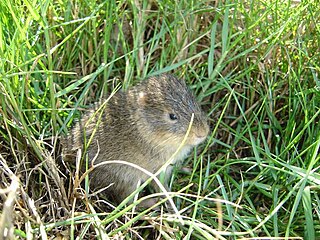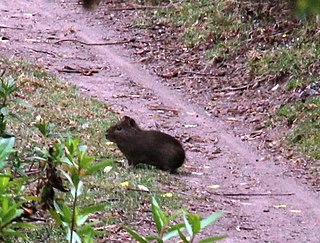
The guinea pig or domestic guinea pig, also known as the cavy or domestic cavy, is a species of rodent belonging to the genus Cavia, family Caviidae. Breeders tend to use the name "cavy" for the animal, but "guinea pig" is more commonly used in scientific and laboratory contexts. Despite their name, guinea pigs are not native to Guinea, nor are they closely related to pigs. Instead, they originated in the Andes region of South America, where wild guinea pigs can still be found today. Studies based on biochemistry and DNA hybridization suggest they are domesticated animals that do not exist naturally in the wild, but are descendants of a closely related cavy species such as C. tschudii. Originally, they were domesticated as livestock in the Andean region and are still consumed in some parts of the world.

Caviidae, the cavy family, is composed of rodents native to South America and includes the domestic guinea pig, wild cavies, and the largest living rodent, the capybara. They are found across South America in open areas from moist savanna to thorn forests or scrub desert. This family of rodents has fewer members than most other rodent families, with 19 species in seven genera in three subfamilies.
A misnomer is a name that is incorrectly or unsuitably applied. Misnomers often arise because something was named long before its correct nature was known, or because an earlier form of something has been replaced by a later form to which the name no longer suitably applies. A misnomer may also be a word that is used incorrectly or misleadingly. The word "misnomer" does not mean "misunderstanding" or "popular misconception", and a number of misnomers remain in common usage — which is to say that a word being a misnomer does not necessarily make usage of the word incorrect.

Caviinae is a subfamily uniting all living members of the family Caviidae with the exception of the maras, capybaras, and Kerodon. The subfamily traditionally contained the guinea pig or cavy-like forms along with the cursorially adapted (running) Kerodon. Molecular results suggest the Caviinae as so defined would be paraphyletic and Kerodon is more closely related to maras and capybaras than to other caviines. This led Woods and Kilpatrick (2005) to unite Kerodon and capybaras into the subfamily Hydrochoerinae within the Caviidae. These studies also suggest Microcavia and Cavia are more closely related to one another than either is to Galea.

Cavia is a genus in the subfamily Caviinae that contains the rodents commonly known as the true guinea pigs or cavies. The best-known species in this genus is the domestic guinea pig, Cavia porcellus, a meat animal in South America and a common household pet outside that continent.

The Skinny Pig or Skinny is an almost hairless strain of guinea pig. Skinny Pigs typically have hair on their muzzles, feet, and legs, but are hairless over the remainder of their bodies. Some of them have a thin covering of fuzzy hair on their backs as well. The Skinny guinea pig is not one of the 13 recognized cavy breeds by the American Cavy Breeders Association. A healthy skinny has skin that is mostly smooth, with some wrinkling around the legs and neck. The body is full with no appearance of spine or ribs. Skinnies can come in a variety of skin colors and patterns, including "Dutch", "Brindle", and "Himalayan". The term "skinny" is used for hairless guinea pigs either because it colloquially refers to the exposed skin of the animal, or because it describes their thinner appearance due to their lack of hair.

The Brazilian guinea pig is a wild guinea pig species found in Argentina, Brazil, Bolivia, Colombia, Ecuador, Guyana, Paraguay, Uruguay and Venezuela.
The shiny guinea pig is a guinea pig species of southeastern South America.

Santa Catarina's guinea pig or Moleques do Sul cavy is a rare guinea pig species of southeastern South America.

Cavia magna, commonly known as the greater guinea pig, is a species of rodent in the family Caviidae, native to South America. It is found primarily in the coastal regions of southern Brazil and Uruguay, inhabiting grasslands, marshes, and other wetland environments. Cavia magna is closely related to the domesticated guinea pig but is distinct in its larger size and semi-aquatic habitat preferences.

The montane guinea pig is a species of caviid rodent found in the Andes in South America. The montane guinea pig is the likely main ancestor of Cavia porcellus, the domestic guinea pig or domestic cavy, which appears to be a hybrid that includes lesser genetic contributions from other Cavia species.
Cavia anolaimae is a guinea pig species from South America. It is found in Colombia near Bogotá. It is believed to be a feral offshoot of the domestic guinea pig, Cavia porcellus, and is often treated as a synonym of C. porcellus, but Zúñiga et al. (2002), based on morphologic characters, recognized them as different species. According to the molecular analysis of Dunnum and Salazar (2010) C. anolaimae is a subspecies of Cavia aperea, C. aperea anolaimae, and a possible synonymous of C. a. guianae.

Cavia guianae is a guinea pig species from South America. It is found in southern Venezuela, Guyana, and portions of northern Brazil. Some biologists believe it to be a feral offshoot of the domestic guinea pig, Cavia porcellus; others subsume it under the wild cavy, Cavia aperea. Molecular data collected show there is little genetic differentiation in C.a. guianae known to be a lowland locality in comparison to C. anolaimae which are predominantly highland populations.

Galea is a genus of South American rodents of the family Caviidae. 5-6 extant species are known, found in Argentina, Bolivia, Chile, Peru and Brazil. They are:

Linda Maria Koldau is a German musicologist and was Chair of Musicology and Cultural History at Aarhus University in Denmark. Since 2013 she has been director of the Coastal Academy in Northern Germany, focusing on efficiency, conciseness and perfection in business language and communication.

Alfred Nehring was a German zoologist and paleontologist. He was a founding professor of zoology at the Royal agricultural university in Berlin.












